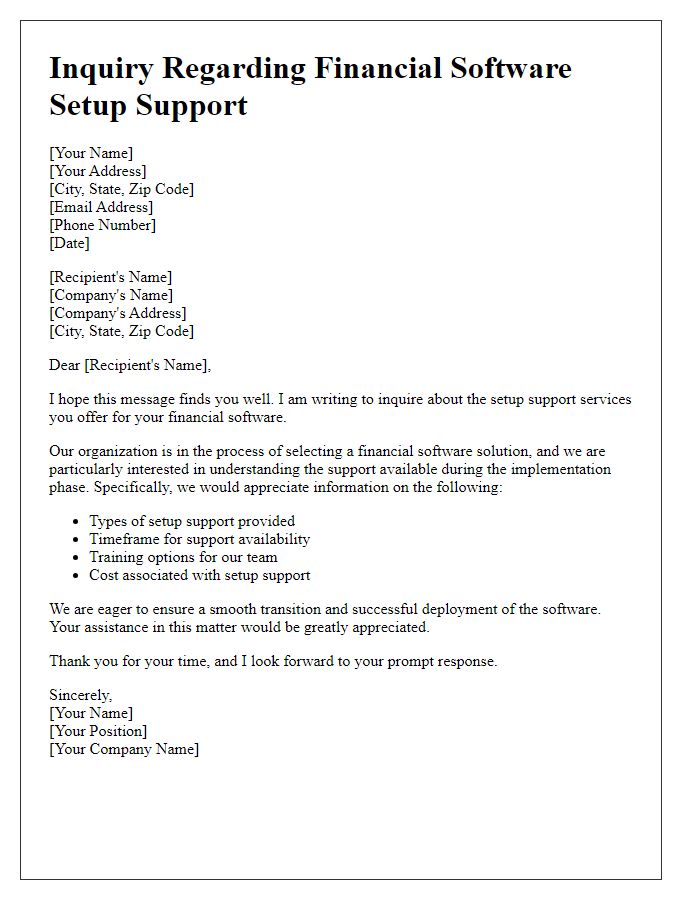Are you considering implementing a new financial software system for your business? Choosing the right software can significantly enhance your financial operations, streamline processes, and improve accuracy. However, navigating the implementation process can be complex and often requires expert support to ensure a smooth transition. Let's dive deeper into how you can successfully roll out financial software and what to look for in support servicesâread on to learn more!

Client's Business Requirements
Effective financial software implementation requires a thorough understanding of the client's business requirements, including specific financial workflows, reporting needs, and compliance specifications. Key factors include aligning the software functionality with the client's industry standards, such as Generally Accepted Accounting Principles (GAAP) or International Financial Reporting Standards (IFRS). Detailed analysis of user roles and permissions is essential to ensure secure access and data integrity in systems deployed across various departments, such as accounts payable, accounts receivable, and payroll. Additional focus on integration capabilities with existing systems, like Customer Relationship Management (CRM) software or Enterprise Resource Planning (ERP) platforms, is critical for a seamless workflow. Furthermore, incorporating training and support resources can enhance user adoption and minimize disruptions during the transition to the new software solution.
Software Capabilities and Features
The financial software implementation phase involves critical features tailored to enhance efficiency and accuracy in financial management. Key capabilities include automated transaction processing, which streamlines data entry and reduces errors, ensuring that financial records are updated in real-time. The software supports various accounting frameworks (e.g., GAAP and IFRS), providing flexibility for businesses across different regions. Advanced reporting tools generate insightful analytics, such as cash flow forecasts and budget variance reports, essential for strategic decision-making. Moreover, integration capabilities with existing enterprise resource planning systems enhance data coherence, minimizing manual effort. User-friendly dashboards facilitate instant access to vital financial metrics, improving visibility and control. Security measures like end-to-end encryption protect sensitive financial data, fostering trust among stakeholders. The implementation journey also includes training sessions in adoption strategies, ensuring users are proficient in navigating the software environment.
Implementation Timeline
Implementing financial software typically involves a structured timeline, spanning multiple phases such as planning, configuration, testing, and training. The initial planning phase usually takes about 4 weeks, with stakeholders from finance departments, IT support, and external consultants meeting to assess company needs, such as compliance with the Generally Accepted Accounting Principles (GAAP). Following this, the configuration phase may last 6-8 weeks, involving customization of software features like budgeting tools and reporting templates. During the testing phase, about 3 weeks are dedicated to quality assurance (QA) for data accuracy, with a focus on transaction processing and user access controls. Finally, the training phase includes instructional sessions for employees, allocated approximately 2 weeks, ensuring proficient use of features like expense tracking and reconciliations in various departments. Overall, this comprehensive process often spans 15 weeks, bridging the gap between planning and full operational deployment.
Training and Support Services
Implementing financial software solutions, such as Enterprise Resource Planning (ERP) systems, requires comprehensive training and support services. Companies, especially in sectors like manufacturing and retail, often face challenges during the transition phase. Training programs should be customized to accommodate various user roles, including finance teams, management staff, and operational personnel, ensuring they fully understand functionalities like budgeting modules (with emphasis on variance reports) and compliance features. Ongoing support services, utilizing channels such as dedicated help desks or online tutorials, are essential for addressing immediate queries and minimizing downtime. Metrics such as user adoption rates and response times for support requests should be monitored to evaluate the effectiveness of training and support initiatives, enhancing overall operational efficiency.
Data Security and Compliance
Data security is crucial in financial software implementation, particularly regarding sensitive information such as personal identification numbers (PINs), banking details, and transaction histories. Compliance with regulations like the General Data Protection Regulation (GDPR) in the European Union and the Payment Card Industry Data Security Standard (PCI DSS) ensures that organizations adhere to best practices in safeguarding customer data. Implementing encryption protocols, such as Advanced Encryption Standard (AES) with a 256-bit key length, protects data during transmission and storage. Regular security audits, conducted at least annually, can help identify vulnerabilities in the system. Additionally, employing multi-factor authentication (MFA) provides an extra layer of security against unauthorized access, enhancing overall data protection strategies and ensuring adherence to compliance requirements.
Letter Template For Financial Software Implementation Support Samples
Letter template of request for financial software implementation assistance

Letter template of solicitation for financial software integration guidance

Letter template of proposal for financial software deployment consultation

Letter template of notification for financial software support requirements

Letter template of communication for financial software troubleshooting aid









Comments